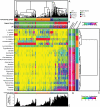Vaginal microbiome of reproductive-age women
- PMID: 20534435
- PMCID: PMC3063603
- DOI: 10.1073/pnas.1002611107
Vaginal microbiome of reproductive-age women
Abstract
The means by which vaginal microbiomes help prevent urogenital diseases in women and maintain health are poorly understood. To gain insight into this, the vaginal bacterial communities of 396 asymptomatic North American women who represented four ethnic groups (white, black, Hispanic, and Asian) were sampled and the species composition characterized by pyrosequencing of barcoded 16S rRNA genes. The communities clustered into five groups: four were dominated by Lactobacillus iners, L. crispatus, L. gasseri, or L. jensenii, whereas the fifth had lower proportions of lactic acid bacteria and higher proportions of strictly anaerobic organisms, indicating that a potential key ecological function, the production of lactic acid, seems to be conserved in all communities. The proportions of each community group varied among the four ethnic groups, and these differences were statistically significant [χ(2)(10) = 36.8, P < 0.0001]. Moreover, the vaginal pH of women in different ethnic groups also differed and was higher in Hispanic (pH 5.0 ± 0.59) and black (pH 4.7 ± 1.04) women as compared with Asian (pH 4.4 ± 0.59) and white (pH 4.2 ± 0.3) women. Phylotypes with correlated relative abundances were found in all communities, and these patterns were associated with either high or low Nugent scores, which are used as a factor for the diagnosis of bacterial vaginosis. The inherent differences within and between women in different ethnic groups strongly argues for a more refined definition of the kinds of bacterial communities normally found in healthy women and the need to appreciate differences between individuals so they can be taken into account in risk assessment and disease diagnosis.
Conflict of interest statement
The authors declare no conflict of interest.
Figures




References
-
- Donders GG, et al. Pathogenesis of abnormal vaginal bacterial flora. Am J Obstet Gynecol. 2000;182:872–878. - PubMed
-
- Gupta K, et al. Inverse association of H2O2-producing lactobacilli and vaginal Escherichia coli colonization in women with recurrent urinary tract infections. J Infect Dis. 1998;178:446–450. - PubMed
-
- Pybus V, Onderdonk AB. Microbial interactions in the vaginal ecosystem, with emphasis on the pathogenesis of bacterial vaginosis. Microbes Infect. 1999;1:285–292. - PubMed
-
- Cherpes TL, Meyn LA, Krohn MA, Lurie JG, Hillier SL. Association between acquisition of herpes simplex virus type 2 in women and bacterial vaginosis. Clin Infect Dis. 2003;37:319–325. - PubMed
Publication types
MeSH terms
Substances
Grants and funding
LinkOut - more resources
Full Text Sources
Other Literature Sources
Medical
Molecular Biology Databases

